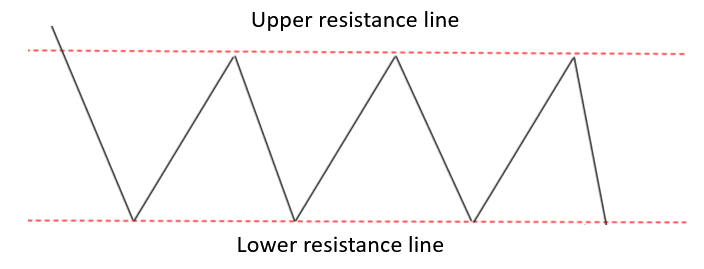- Summary:
- A range bound trading strategy is another way to trade the financial markets. Read our article to learn more about this popular trading strategy.
Table of Contents
Using a range bound trading strategy is another way to trade. Financial market prices tend to either trend or be range bound, or a state between range bound and trending. Knowing how to trade both types of markets can be advantageous. A range bound trading strategy is based on the tendency of prices to revert back to their average price or equilibrium price after a particular period of time. This theory has been implemented in various trading strategies over decades and involves the purchase or sale of stocks, currencies and other assets, based on the relation between their current price and average prices. It should be noted, however, that this approach is not risk-free due to the presence of certain factors. These factors include fundamentals and speculative forces, which are responsible for pushing the price either above or below its historical average, and the price can remain out of line with its average price for an extended period of time before finally reversing and returning to its average. There are many traditional valuation models for currencies which are based on the concept of mean reversion. If we take the Purchasing Power Parity model (PPP) as an example, it suggests that the exchange rate of two currencies are in equilibrium when their purchasing power is the same in each of the two countries. This means that the exchange rate between two countries should equal the ratio of the two countries’ price level of a fixed basket of goods and services. When a country’s domestic price level is increasing (i.e., a country experiences inflation), that country’s exchange rate must depreciate in order to return to PPP. However, due to the tendency of exchange rates being significantly overvalued or undervalued compared to their PPP exchange rate, this model suggests buying undervalued currencies, while selling overvalued currencies. This is done with the assumption that the market rate will revert back to its equilibrium exchange rate over time. As for retail traders, they tend to stick to simpler and mean-reverting strategies based on technical analysis.
Range bound trading using technical analysis
The first step to implement a range bound trading strategy is to identify a market that is trading sideways, or stationary as it is called in the academic world, because applying a range bound strategy to a trending market is an easy way to lose money and is typically how the retail trader will blow up their accounts.Look at the right place
Some markets will be more range bound than others, and commodities and certain Forex pairs will be more prone to oscillate. Markets that do not tend to remain stationary are the major US stock indices and major FX pairs. However, major pairs such as EURUSD will sometimes trade sideways for up to a year or so, but will most of the time it will have some sort of trend for the pair. Minor FX pairs such as EURGBP, AUDNZD, AUDCAD, but also the USDCHF tend to be range-bound.Find a Range Bound Market Using the Daily Chart
I prefer finding a range bound market using the daily chart. Price ranges can also be found in smaller time frames, and some traders will trade small ranges of 10 to 15 pips in the Asian trading session, but ranges on the daily chart tend to be more stable. Also, if the range is wide it is possible to achieve better risk-reward ratios, and this is typical for setups in the daily chart.Pin Point Support and Resistance levels
When you have found a range bound markets use the daily chart to pinpoint support and resistance levels. In the example below the USDCHF started to oscillate in April 2016 after bouncing from the 0.95 area, and followed up with a double bottom in May at the same level (see the green arrows). The price then created a high in late May, and tested the 0.95 level in June, here in the blue rectangle it would have been a good idea to buy with stop loss orders just below the blue line around 0.9450. As we can see from the example below, it will take a few months for a good range to establish itself on the daily chart.Target the Mid-Point of the Trading Range
Some Forex traders would have targeted the other side of the range, but more than often the price will just reach the mid point of the range, and in the example below that level is the 0.9772 level. Depending on your entry you would have risked about 128 pips to make 141 pips, which is rather typical risk-reward ratio for range bound strategies.


